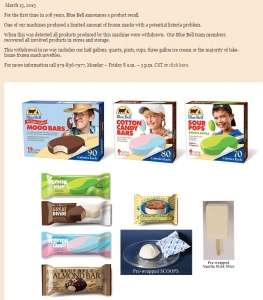
BRENHAM (WBAP/KLIF News) – On March 13, 2015 disaster hit the nation’s third-largest ice cream maker. The Centers for Disease Control and Prevention linked Blue Bell’s desserts to 10 Listeria infections, including three deaths, which forced the Brenham-based company to recall some of its frozen treats.
It was the “first time in its 108-year history” that Blue Bell had issued a recall. The company explained that it had pulled “a limited amount” of products with a “potential listeria problem.” It emphasized that the recall “in no way” involved other snacks. In the months to follow, the ice cream company found itself issuing four more recalls and eventually pulling all of its products from store shelves in 23 states.
Blue Bell CEO Paul Kruse apologized, saying everyone at Blue Bell was “heartbroken.” He said the company had hired “one of the world’s most respected food-safety microbiologists” to “get to the bottom of this issue.”
One year later, WBAP/KLIF News takes a look back at how the “Little Creamery in Brenham” handled the contamination episode:
“I think the recall was done properly,” said Bill Coleman, a branding expert and the CEO of Blue Ocean 2. “However, there was a problem with the way the company handled the initial problem.”
According to Coleman, the brand’s slow response is known to industry experts as “recall creep,” where executives take limited action, hoping the issue will fix itself. However, they are usually forced to expand the recall numerous times. “If you take five different recalls to actually get to the problem and solve it, that creates a concern among consumers. What that does to your brand is take it from a ‘brand hit’ to a ‘brand erosion,'” added Coleman.
Listeria bacteria was found in Blue Bell’s Oklahoma plant in March 2013, but the company failed to solve the problem, according to an inspection report from the U.S Food and Drug Administration. Despite 16 positive tests of Listeria at the plant between March 2013 and January 2015, the company continued to package and sell ice cream. Although it was identified as an infection outbreak in 2015, it was sickening people as early as 2010, according to the CDC bacterial registry. “The fact that it was the same strain over the last five years suggests it could have lurked somewhere in the factory the whole time,” said Dr. Robert Tauxe, deputy director of the CDC Division of Foodborne, Waterborne and Environmental Diseases.
Coleman said Blue Bell could have learned from Johnson & Johnson during its Tylenol-tampering episode in 1982. “It’s actions were the exact opposite. Executives at Johnson & Johnson didn’t deny the problem by elongating it. They acknowledged it. They saved their reputation by recalling every bottle of medication, and they moved forward. The president of the company talked about the concern he had for the consumers first. He demonstrated that Johnson & Johnson was nothing without its consumers. If Blue Bell had engaged consumers, I think it would have helped them.”
Click to hear WBAP/KLIF’s Chelsea Wade talk with Coleman:
According to an article published by the Houston Chronicle in September, more than a dozen ex-employees came forward with problems at the plant in Brenham. The employees said they complained to supervisors about a number of sanitary and safety issues at its flagship plant, but nothing was ever done. “I’m hoping that there isn’t anything more, but where there is smoke, there is fire relative to your employees,” said Coleman.
“It’s going to be challenging for Blue Bell to restore its brand and go up against some of the larger players like Ben and Jerry’s and Häagen-Dazs, especially outside of the South,” said Coleman.
According to the company’s website, it “thoroughly cleaned and sanitized” its facilities and re-trained its workers. It resumed production in Alabama in July, then in Oklahoma in September. Blue Bell is only planning to expand into 15 states, instead of the previous 23. The iconic tubs of ice cream began returning to store shelves in August. It restarted its largest plant in Brenham in November.
The following 12 flavors are currently available in the “half gallon” size:
Butter Crunch
Buttered Pecan
Cherry Vanilla
Chocolate Chip Cookie Dough
Coffee
Cookies ’n Cream
Dutch Chocolate
Homemade Vanilla
Natural Vanilla Bean
Pistachio Almond
Rocky Road
The Great Divide®




